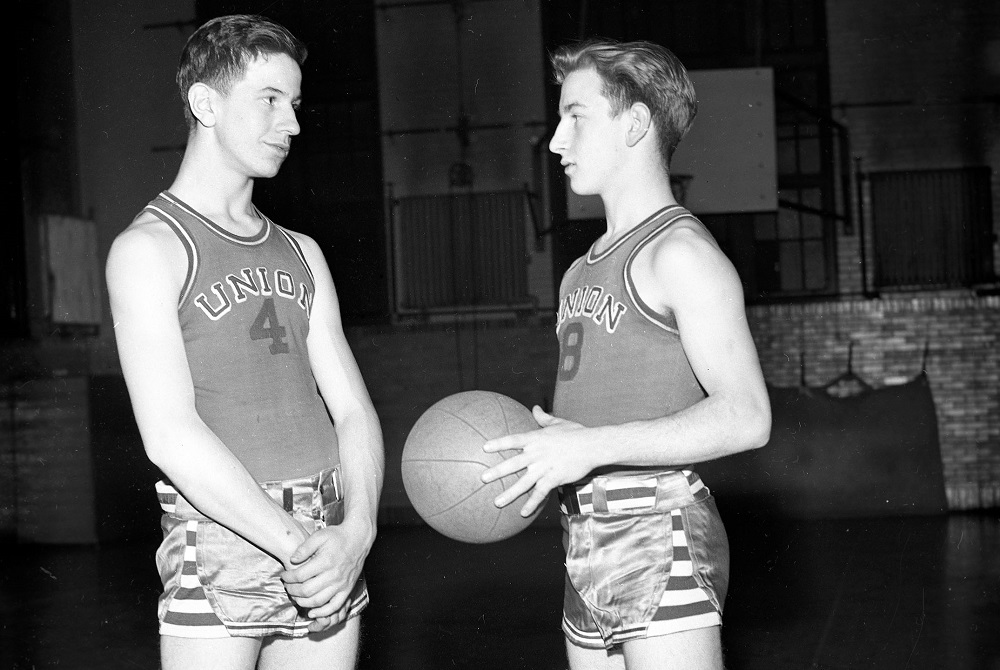
Longtime Coach Researches Photos to Tell Story of Grand Rapids Sports' Past
By
Steve Vedder
Special for MHSAA.com
September 16, 2022
GRAND RAPIDS – Bob Schichtel always pauses when he comes across the ancient black and white photo long enough to ponder whatever became of the two youngsters adorned in Grand Rapids Union basketball uniforms.
The posed shot shows two players facing each other in a local gymnasium in a photo apparently taken four days after the Japanese surprise attack on Pearl Harbor in 1941 that launched the country into World War II. Only a handful of fans today would recognize the players' striped, ultra-short shots and simple sleeveless shirts with "Union" emblazed across the front as recognizable basketball uniforms. One holds a battered-looking basketball, while the other looks on. The two players, whose uniform numbers are "4" and "9," aren't really smiling, but still seem as close as any teammates, whether 81 years ago or today.
In fact, it's the look the youngsters share that intrigues Schichtel, whose thankless, pro bono job it is to identify the two players.
"Once you start," said Schichtel, a former longtime Grand Rapids basketball coach, "it's like looking down a deep rabbit hole."
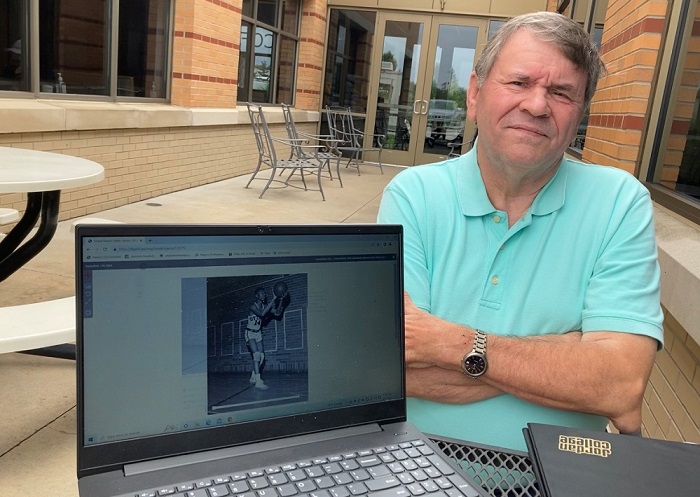 Schichtel works as a volunteer for the Grand Rapids Public Library trying to identify mostly former Grand Rapids City League basketball players from approximately 1938 through the early fifties. The online photos are mostly from the Robinson Photo Studio Collection taken in conjunction with the Grand Rapids Herald newspaper. The library says the unique collection spans some 950 basketball negatives from the entire Robinson/Herald collection that totals well over 900,000 Grand Rapids photos.
Schichtel works as a volunteer for the Grand Rapids Public Library trying to identify mostly former Grand Rapids City League basketball players from approximately 1938 through the early fifties. The online photos are mostly from the Robinson Photo Studio Collection taken in conjunction with the Grand Rapids Herald newspaper. The library says the unique collection spans some 950 basketball negatives from the entire Robinson/Herald collection that totals well over 900,000 Grand Rapids photos.
While the work – which amounts to a ton of patience combined with a detective ability – can be exhausting, it's still what Schichtel describes as a labor of love. For example, there's the shot of the two still-unidentified Union players. Schichtel looks at the photo and can't help but wonder whatever happened to the kids. Were they exceptional athletes? Did they leave their marks on Grand Rapids history, whether it was in education, politics, business, industry, the arts or another field? He doesn't even know, as in many photos from this era, whether the two entered the military and thus even survived World War II.
Schichtel has searched everywhere for the answers, but has come up short. Too many times, in fact.
Which isn't to say he'll quit looking or chalk up his research as inconsequential. Schichtel said the foremost reason he spends hours on the project is that many of the athletes he identifies deserve the recognition for achievements far beyond basketball. In many cases former City League basketball, football, baseball, track and tennis athletes became the foundation on which Grand Rapids was built. If Schichtel can uncover an old photo which depicts these youngsters during their high school careers, so much the better, he said.
"It's important to recognize Grand Rapids sports history, and I don't know if we've given enough attention to their past," Schichtel said. "They are what got us here, and I'm a firm believer they need to be recognized for it."
Figuring out that history, however, ranges from, at the least, extremely time consuming to – in too many frustrating cases – virtually impossible. The City League was formed in the late 1920s and featured original schools Grand Rapids Central, Creston, South, Union, Ottawa Hills, Catholic Central and Davis Tech. The league was eventually folded into the Ottawa-Kent Conference in 2008.
"It was a long, evolving league," Schichtel said.
 The identification tools available to Schichtel are actually more numerous than most would suspect. For starters, he's formed an impressive database of information by pouring through old City League yearbooks and programs, photos from other collections and microfilm of old newspapers, And then there's also the knowledge gathered by Schichtel himself, a 1968 Grand Rapids Catholic Central graduate. After playing in many old City League gymnasiums, Schichtel went on to compile a 389-197 record in 27 years as the Cougars girls basketball coach. He uses countless City League contacts as both a player and coach to identify athletes. In all, Schichtel taught in the Grand Rapids school system for 34 years.
The identification tools available to Schichtel are actually more numerous than most would suspect. For starters, he's formed an impressive database of information by pouring through old City League yearbooks and programs, photos from other collections and microfilm of old newspapers, And then there's also the knowledge gathered by Schichtel himself, a 1968 Grand Rapids Catholic Central graduate. After playing in many old City League gymnasiums, Schichtel went on to compile a 389-197 record in 27 years as the Cougars girls basketball coach. He uses countless City League contacts as both a player and coach to identify athletes. In all, Schichtel taught in the Grand Rapids school system for 34 years.
He also uses the game itself to identify the photos. For instance, he can pinpoint some photos simply by the styles of the uniforms worn by players. He also figures out who is who by other clues such as what the players are doing in the photo. If a player is taking a set shot in the photo, it's likely pre-World War II. The beginnings of the jump shot, or what Schichtel calls "elevation while shooting," is probably mid-1940s. In addition, Schichtel can identify photos through pure basketball athleticism. Players can look a bit awkward in shots from the thirties as compared to players from the late 1940s who were beginning to play with a more obvious flare.
Put all the information together and Schichtel, who has uncovered more than two dozen personal connections to subjects in the photos, believes he has a reasonable shot at identifying them.
Since he signed on with the project, Schichtel figures he's identified about 10 percent of the photos he's viewed. Among the City League athletes he's found shots of Central's John Lavan, who was born in 1890 and played Major League Baseball during the Babe Ruth era and became a military hero who is buried in Arlington National Cemetery; Creston basketball player Roger Wilkins, an assistant United States attorney general during the Watergate hearings; Art Spoelstra of Godwin, a former NBA player and member of the Grand Rapids Hall of Fame; and Grand Rapids native Bill Cutler, who turned a chance post-World War II meeting with then-American League president Will Harridge into a position as commissioner of the Pacific Coast League,
Schichtel said gaining information through photos on the people who became the bedrock of Grand Rapids should be celebrated.
"I think it's a great approach for the community; they shouldn't be forgotten," Schichtel said. "Who else is going to do this? Why do I do it? I see a certain, for lack of a better word, a nobility. These kids played for the love of game, and they became the “Greatest Generation.” These kids did great things. It's not just, 'Well, there's No. 58,’ in a photo.
"You want to know more about them. That's the real intrigue for me."
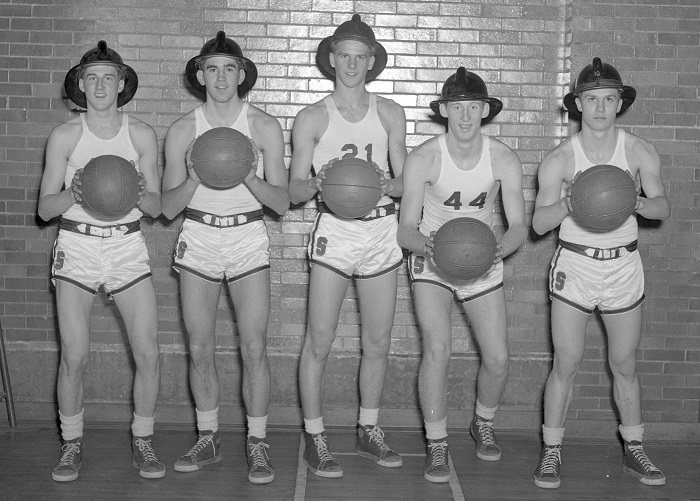 Tim Gloege of the Grand Rapids Public Library said the collection of photos – and their identification – is continually growing. As more people log onto the library's website, more people want to either add to the collection or have information that leads to an identification. The library estimates about 1,200 photos are searched monthly. But as time grows, many of the original photos are disintegrating. The library is in a constant state of preservation, Gloege said.
Tim Gloege of the Grand Rapids Public Library said the collection of photos – and their identification – is continually growing. As more people log onto the library's website, more people want to either add to the collection or have information that leads to an identification. The library estimates about 1,200 photos are searched monthly. But as time grows, many of the original photos are disintegrating. The library is in a constant state of preservation, Gloege said.
"It's a massive project, and we're working to get as many photos online as possible," he said. "The numbers (of photos) we have are rising pretty significantly as people post them on social media.
"When you think of the past and now, you need to realize these are people, kids who used to play basketball and did other things. The work is hard and very time-intensive, but it brings a whole new dimension to history."
Schichtel said he's "kind of picked the low-hanging fruit" on many of the easy photos to identify. But the work will continue.
"Yes, it can be frustrating," he said. "There are limitations if you want it to be accurate. Sometimes you look at a photo and you know it's not going to happen, and you move on. But this a chance to learn about people who made Grand Rapids what it is. That's important to me."
PHOTOS (Top) Two Grand Rapids Union basketball players stand for a photo taken Dec. 12, 1941. (2) Longtime area coach Bob Schichtel researches hundreds of photos that are part of the Grand Rapids Public Library archive. (3) Schichtel has identified these 1941 Grand Rapids Ottawa Hills basketball players as James Horn (left) and Chuch Reynier. (4) Schichtel identified Grand Rapids South High’s “Fireman Five” of, from left, Fred Esslair, Lee Morrow, Jack Carroll, Bob Youngberg and Bruce Bigford. (Historic photos courtesy of the Grand Rapids Public Library.)
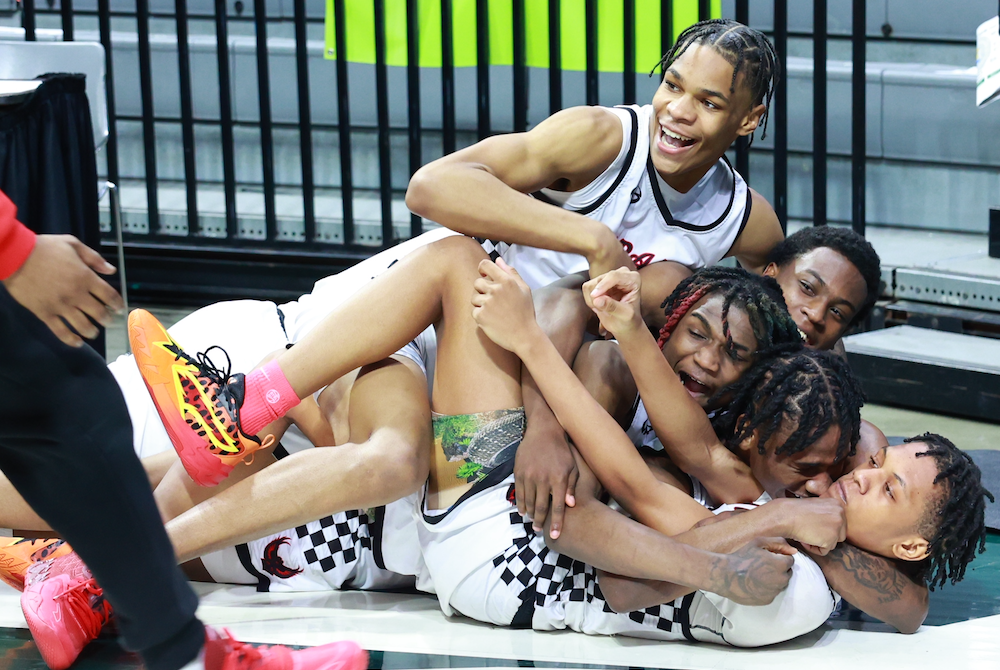
Boyd Finds Nothing but Net as Old Redford Earns Championship Day Debut
By
Keith Dunlap
Special for MHSAA.com
March 14, 2024
EAST LANSING — The day before his team’s Division 3 Semifinal against Riverview Gabriel Richard, Detroit Old Redford head coach Ray Reeves said he installed a new play for his team to run.
Lo and behold, Old Redford found itself running that play Thursday at its most important moment of the season.
The Ravens were trailing by a point with two seconds remaining in regulation and set to inbound the ball from underneath their basket.
The play was called “one,” mainly because it was one of five new plays Reeves said were installed.
“I was watching Auburn play and I saw (head coach) Bruce Pearl run it,” Reeves said. “I took it from him.”
That play ended up earning Old Redford a chance to finish this season “one” in the state, as senior Justin Austin inbounded the ball into the near corner on the left side of the floor to junior Arkell Boyd, who drained a heavily-contested 3-pointer just before the buzzer to give the Ravens a 43-41 win over Gabriel Richard.
Old Redford will meet Niles Brandywine at 4:30 p.m. Saturday in a matchup of teams making their first appearance in an MHSAA Final in this sport.
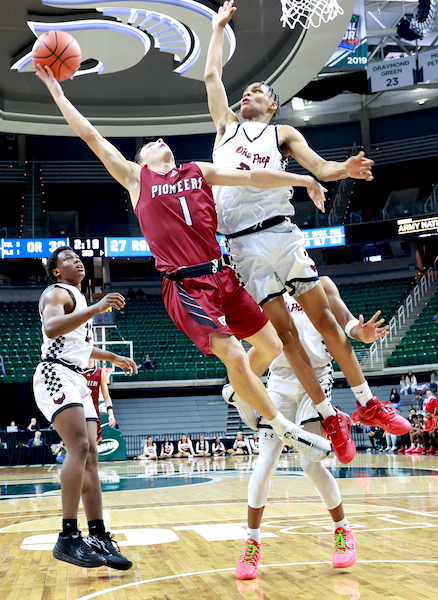 “When that particular play came at the end of the game, I knew what to do,” said Boyd, who was mobbed by teammates on the floor after the shot went in.
“When that particular play came at the end of the game, I knew what to do,” said Boyd, who was mobbed by teammates on the floor after the shot went in.
The win continued a magical journey for Old Redford, which earned a one-point win over 2023 champion Flint Beecher in the Quarterfinal and a two-point victory over Detroit Loyola in a Regional Final.
Expanding on his team’s run this season, Reeves said the pivotal moment came during a trip to Indiana earlier in the year that produced some roster attrition.
“We went to Indiana with 14 players and came back with nine,” Reeves said.
The roster cut came after what Reeves said were issues with overbearing parents, which he said produced a team meeting that lasted from 10 p.m. until roughly 7 a.m. the next morning in Indiana.
“We knew it had to change,” Reeves said. “You think as an adult it would sometimes get better because you are dealing with adults. But I realized it was getting worse and it was killing my team. We came together that night, and we haven’t looked back.”
Trailing 37-32 with 4:42 remaining, Gabriel Richard mounted a charge, going on a 7-0 run to take a 39-37 lead with 2:01 left following a 3-point play by junior Nick Sobush.
Old Redford tied the game at 39-39 with 33.8 seconds remaining on a steal and layup by junior Kason Mayes, but Gabriel Richard regained the lead at 41-39 with 14.3 seconds left with a layup by junior Luke Westerdale.
Following a timeout, Old Redford put the ball in the hands of Mayes, who was fouled on a layup attempt with 3.3 seconds to go.
Mayes made the first free throw and missed the second to make it 41-40 Gabriel Richard. But Old Redford got the ball back when the rebound went off a Gabriel Richard player, which set up Boyd’s heroics.
Mayes scored 16 points, and Boyd added 15 for Old Redford (21-7).
Junior Charles Kage had 15 points and nine rebounds, and Sobush added 13 points for Gabriel Richard (23-4).
“It’s tough to swallow,” Gabriel Richard head coach Kris Daiek said. “I thought our kids played hard. But hey, it happens. It’s March Madness.”
The good news for Gabriel Richard is that all six players who saw minutes Thursday are expected back to help the program expand on what was its first Semifinal appearance since 1989.
“This is an educational moment for my kids,” Daiek said. “It stinks now. I give credit to Old Redford. It was a great battle all the way down the stretch. This will build character and make us a little bit tougher.”
PHOTOS (Top) Teammates pile onto Detroit Old Redford’s Arkell Boyd after his game-winning basket Thursday at Breslin Center. (Middle) The Ravens’ Ja'Quan Stennis gets a hand up high as Gabriel Richard’s Nick Sobush (1) works to get off a shot. (Photos by Hockey Weekly Action Photos.)

